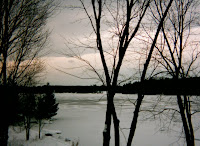The birds and squirrels are frantically raiding the bird feeders.
The woodpeckers, especially, like the new Lee Valley bird feeder. (A present from my daughter!) It collapses and has a wire outer edge.
I'm sure, once the 'coons arise from slumber, I shall be forced to retrieve it nocturnally, during last call for cats in the spring!

My favourite squirrel posed for me. His ear tufts are so adorable! But he is a bit skittish and runs when I open the door. I could clean the sliding glass doors, but it is so cold!
Margy write of
Boats, Floats and Mountain Goats. None here, I am afraid.
 Carolyn
Carolyn responding to a previous post, reminds us of snowmobiles and avalanches out west. (She is visiting Ottawa, where I lived for 25 years!) My darling granddaughter was baking cookies with her other grandma. We had great summer visits!
It being the anniversary (is there a better word?) of the deaths of snowmobilers I scan our frozen lake with dubious confidence.
The Globe celebrated the B.C. event by catching up on the small town ravaged by the horrific loss of 8 snowmobile riders. Another, who survived the tragedy, appears to have suffered PTSD and will never be the same.
Dec 26, 2009 ... After eight snowmobilers died in a back country avalanche three days after Christmas, 2008, survivors still feel guilt but ride on.
It is sad that many horrible things happened on Dec. 26th; Boxing Day to Canadians, my birthday to me and my family! The tsunami was written about, as well as this horrible event.
In the meantime, I took the cats down to the lake for a bit of walkies. They are so grouchy and play fight indoors, whinging in the sunlight in the window, whining to come back in shaking snow off frozen paws. You can see the fox prints at Sady's feet. Animals continue their fight for food.
Hubby, doing errands, and walking our client's dog, usually does this. I figured it was my turn.
The ice was nice and solid close to the shore, after night-time double-digit negative temperatures.
I noticed that large snowflakes had fallen, and were shining and sparkling like beacons, drawing me and my camera. They were hard to capture. But they caught my eye.
I was somewhat frozen and the cats weren't up to a full walk. I may not see them again, as the wind has covered them since with snow. Carpe Diem!!!!

This one looked like a maple leaf! Isn't that a hoot?
I trod on through the snow, feeling akin to Good King Wenceslas, but not inclined to sing. I deigned to wear socks, and was grateful for lined boots.
My scarf I was too cold to wrestle with. Hastening my trip I trod on, camera in hand. The sun, out for a time, has since been hidden by Lake Effect Snow Clouds.

Yes, they deserve capitals letters. They are an entity in and of themselves. Well worthy of respect and salutation. We seem to be christened with a several cm a day by these winds. Once Georgian Bay freezes up a bit more they will lessen. In the meantime we simply dress for it. I, for one, am grateful not to have yard duty any more. Stupidvising intermediate teens (hormones on legs!) wearing little clothing, and not much sense, made me feel the cold in my heart, when I was not cold in my body.
The grasses I bought have survived a 2nd year, and true to their claims in my gardening magazines, they look as spectacular in winter as in summer. As long as I prop them with a collar!

The beautiful wine-coloured sumac berries have been shed, their red and orange leaves gone to death and decay beneath the snow. Their buds are ready for spring. A sign of hope.

The seasons, they change.
On that we can depend.

 Part of writing poety, is reading it!
Part of writing poety, is reading it!





































